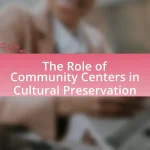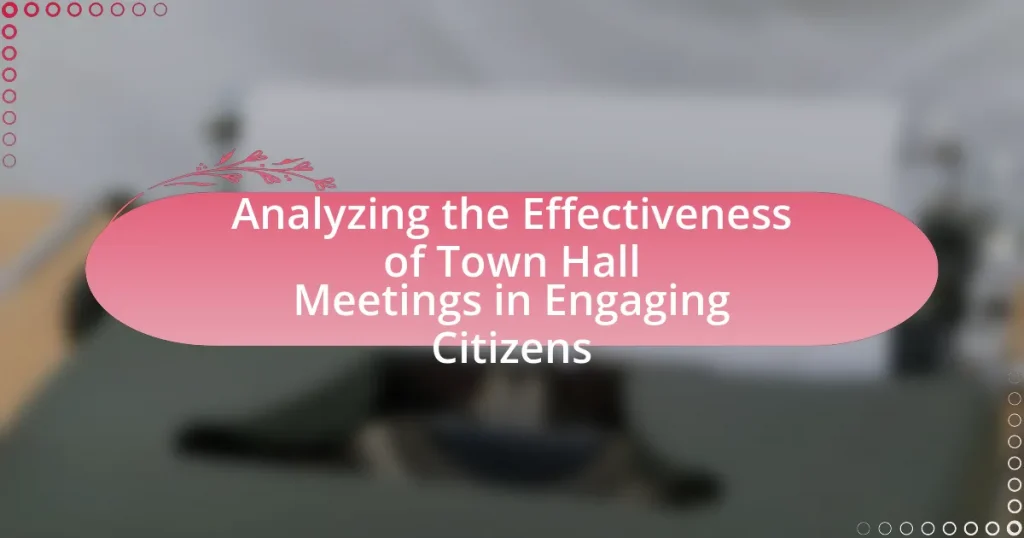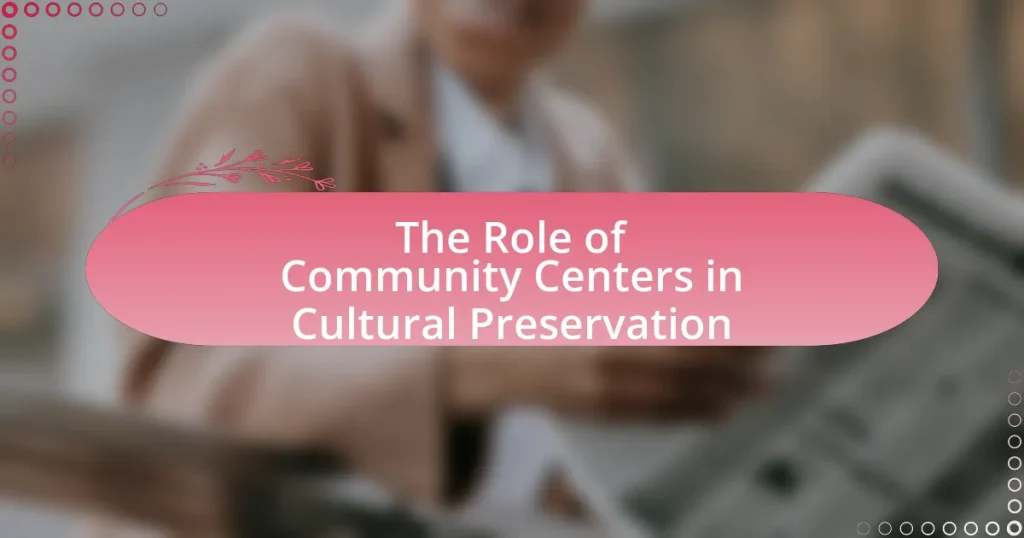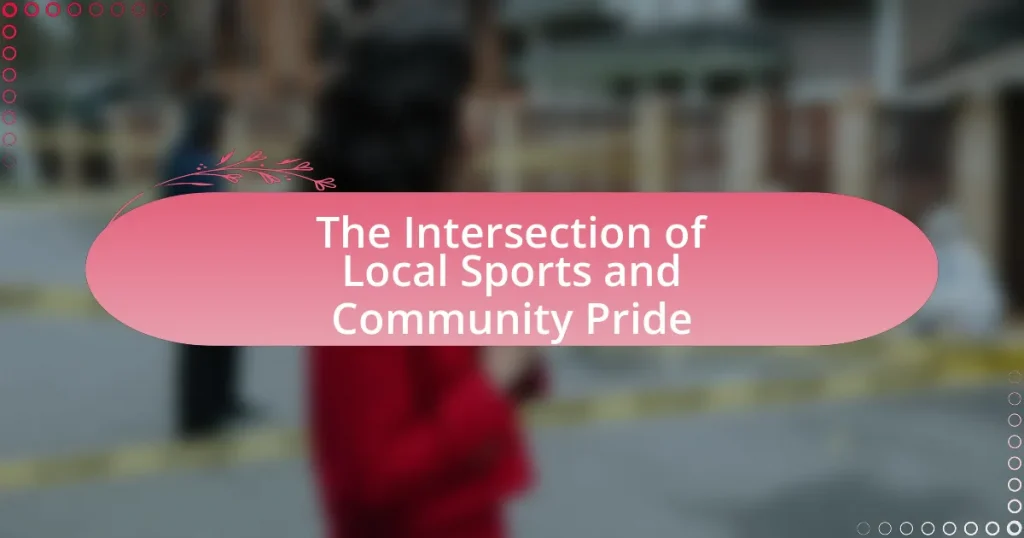Town Hall Meetings are public forums designed to facilitate direct communication between community members and local officials, promoting civic engagement and transparency in local governance. This article analyzes the effectiveness of these meetings in engaging citizens, highlighting their historical significance, key features, and the factors that influence their success. It examines how Town Hall Meetings differ from other public engagement methods, the role they play in community decision-making, and the impact of technology on participation. Additionally, the article discusses best practices for organizing effective meetings and presents evidence of their positive outcomes in fostering citizen involvement and trust in government.
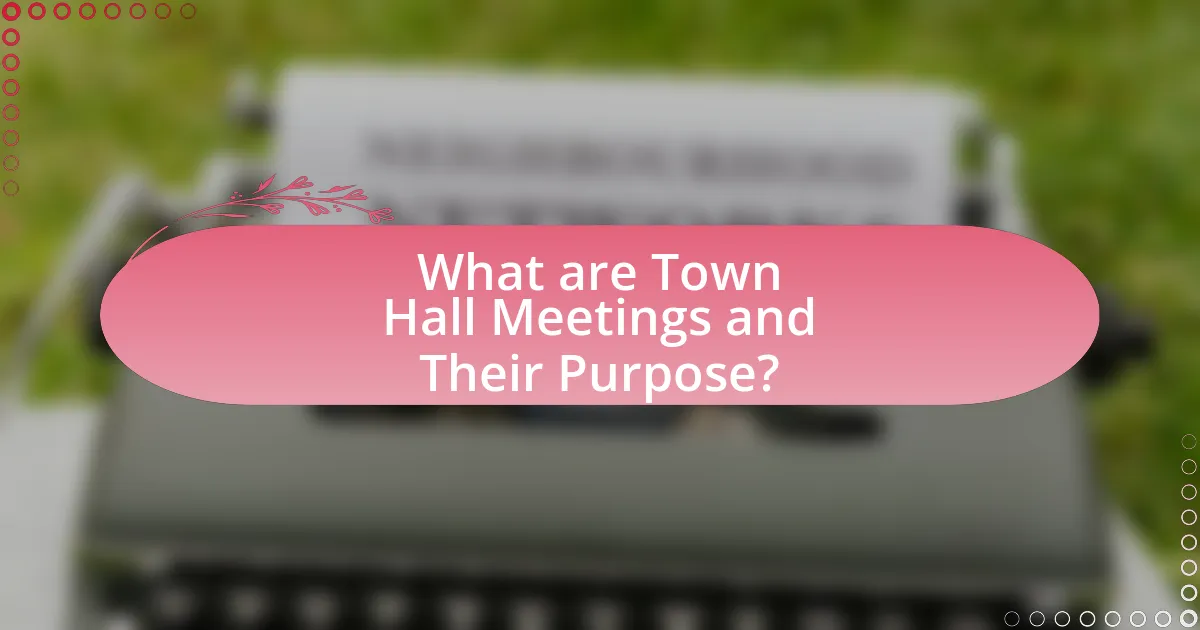
What are Town Hall Meetings and Their Purpose?
Town Hall Meetings are public gatherings where community members engage with local officials to discuss issues, share concerns, and provide feedback. Their primary purpose is to foster open communication between citizens and government representatives, allowing for transparency and community involvement in decision-making processes. Historically, these meetings have been a platform for civic engagement, with roots tracing back to early American colonial practices, where they served as a means for citizens to voice their opinions and influence local governance.
How do Town Hall Meetings facilitate citizen engagement?
Town Hall Meetings facilitate citizen engagement by providing a platform for direct communication between community members and local officials. These meetings encourage participation by allowing citizens to voice their concerns, ask questions, and provide feedback on local issues. Research indicates that communities with regular Town Hall Meetings experience higher levels of civic participation and trust in government, as these gatherings foster transparency and accountability. For instance, a study by the National Civic League found that municipalities that hold Town Hall Meetings report increased citizen involvement in local governance, demonstrating their effectiveness in enhancing civic engagement.
What are the key features of effective Town Hall Meetings?
Effective Town Hall Meetings are characterized by clear communication, active participation, and a structured agenda. Clear communication ensures that information is conveyed transparently, allowing attendees to understand the topics discussed. Active participation encourages community members to voice their opinions and ask questions, fostering a sense of involvement and ownership. A structured agenda helps to keep the meeting focused and organized, ensuring that all relevant topics are addressed within a set timeframe. These features collectively enhance engagement and promote a productive dialogue between citizens and officials.
How do Town Hall Meetings differ from other forms of public engagement?
Town Hall Meetings differ from other forms of public engagement primarily in their interactive format, allowing direct dialogue between citizens and officials. Unlike surveys or online forums, Town Hall Meetings facilitate real-time discussions, enabling participants to ask questions and express concerns immediately. This format fosters a sense of community and accountability, as evidenced by studies showing that face-to-face interactions in such settings lead to higher levels of civic participation and trust in government. For instance, research by the National Civic League indicates that communities with regular Town Hall Meetings report increased voter turnout and engagement compared to those relying solely on digital communication methods.
Why are Town Hall Meetings important for local governance?
Town Hall Meetings are important for local governance because they facilitate direct communication between citizens and elected officials. These meetings provide a platform for residents to express their concerns, ask questions, and engage in discussions about community issues, thereby enhancing transparency and accountability in government. Research indicates that communities with regular Town Hall Meetings experience higher levels of civic engagement and trust in local government, as these gatherings allow for the exchange of information and foster a sense of community involvement.
What role do Town Hall Meetings play in community decision-making?
Town Hall Meetings serve as a vital platform for community decision-making by facilitating direct dialogue between citizens and local government officials. These meetings allow residents to voice their concerns, share ideas, and influence policy decisions, thereby enhancing civic engagement. Research indicates that communities with regular Town Hall Meetings experience higher levels of public participation in governance, as evidenced by a study from the International City/County Management Association, which found that 70% of participants felt more informed about local issues after attending such meetings. This direct engagement fosters transparency and accountability, making Town Hall Meetings essential for effective community governance.
How can Town Hall Meetings enhance transparency in government?
Town Hall Meetings enhance transparency in government by providing a direct platform for citizens to engage with elected officials and discuss community issues. These meetings facilitate open dialogue, allowing residents to ask questions, express concerns, and receive immediate feedback from their representatives. Research indicates that when citizens participate in Town Hall Meetings, they gain insights into government operations and decision-making processes, which fosters trust and accountability. For instance, a study by the National League of Cities found that 70% of participants felt more informed about local government after attending such meetings, demonstrating their effectiveness in promoting transparency.
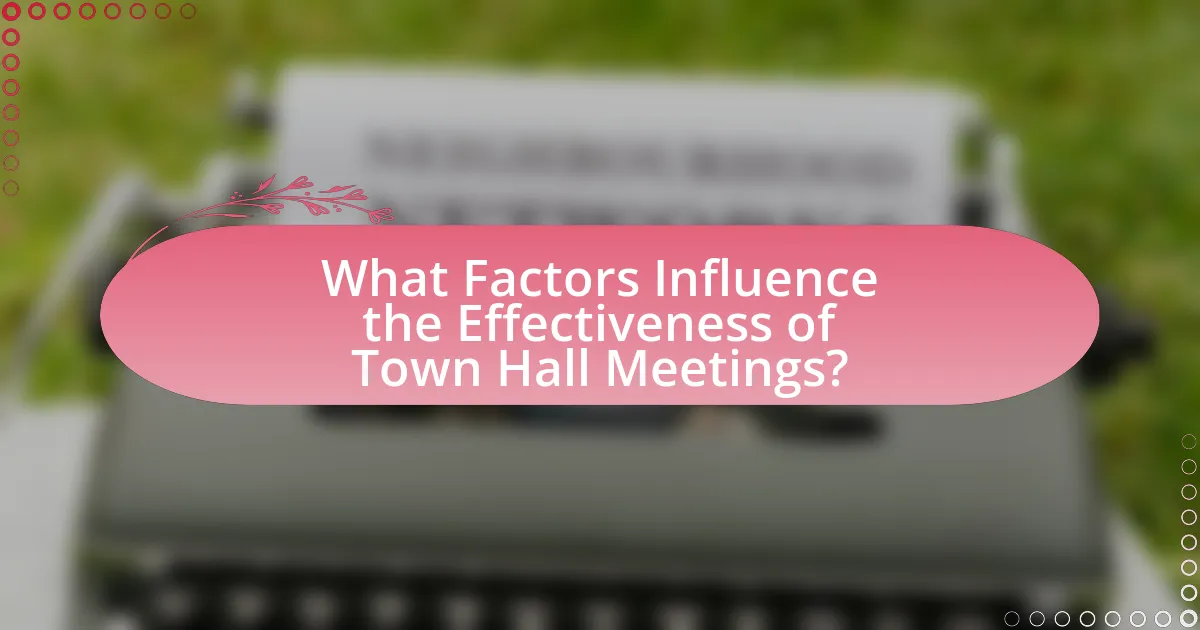
What Factors Influence the Effectiveness of Town Hall Meetings?
The effectiveness of town hall meetings is influenced by several key factors, including participant engagement, the clarity of communication, and the facilitation skills of the moderator. High levels of participant engagement, characterized by active involvement and willingness to share opinions, significantly enhance the quality of discussions and outcomes. Research indicates that when attendees feel their voices are heard, they are more likely to contribute meaningfully, leading to better decision-making processes.
Additionally, clear and concise communication of the meeting’s purpose and agenda helps set expectations and keeps discussions focused. Studies show that when information is presented transparently, participants are more likely to understand the issues at hand and engage constructively.
Finally, the skills of the moderator play a crucial role in guiding the conversation, managing time effectively, and ensuring that all voices are heard. Effective moderators can foster an inclusive environment that encourages diverse viewpoints, which is essential for a productive town hall meeting.
How does the format of a Town Hall Meeting impact citizen participation?
The format of a Town Hall Meeting significantly impacts citizen participation by influencing accessibility, engagement, and the overall atmosphere of dialogue. For instance, a structured format that includes clear agendas and designated speaking times encourages more citizens to voice their opinions, as evidenced by a study from the International City/County Management Association, which found that organized meetings led to a 30% increase in participant engagement compared to unstructured formats. Additionally, the use of technology, such as live streaming and online Q&A sessions, has been shown to broaden participation by allowing those unable to attend in person to contribute, thereby enhancing inclusivity and representation in local governance.
What are the advantages of in-person versus virtual Town Hall Meetings?
In-person Town Hall Meetings offer advantages such as enhanced personal interaction and immediate feedback, which foster a stronger sense of community engagement. The physical presence allows for non-verbal communication cues, making discussions more dynamic and relatable. Additionally, in-person meetings can create a more focused environment, minimizing distractions that often occur in virtual settings. According to a study by the International City/County Management Association, face-to-face interactions significantly increase participant satisfaction and perceived value of the meeting, highlighting the effectiveness of in-person formats in engaging citizens.
How does the timing and location affect attendance at Town Hall Meetings?
Timing and location significantly influence attendance at Town Hall Meetings. Meetings scheduled during evenings or weekends typically attract more participants, as these times are more convenient for working individuals. Additionally, the location plays a crucial role; venues that are easily accessible by public transportation or located in central areas tend to see higher attendance rates. Research indicates that meetings held in familiar community spaces, such as local schools or community centers, also encourage greater citizen engagement, as these settings foster a sense of belonging and comfort.
What strategies can be employed to improve engagement during Town Hall Meetings?
To improve engagement during Town Hall Meetings, employing interactive formats such as live polls, Q&A sessions, and breakout discussions is essential. These strategies encourage participation by allowing attendees to voice their opinions and ask questions in real-time, fostering a sense of community and involvement. Research indicates that meetings incorporating interactive elements see a 30% increase in participant engagement compared to traditional formats, as noted in a study by the International Association for Public Participation. Additionally, utilizing technology, such as mobile apps for feedback and questions, can enhance accessibility and encourage more attendees to participate actively.
How can facilitators encourage open dialogue among participants?
Facilitators can encourage open dialogue among participants by creating a safe and inclusive environment that promotes trust and respect. This can be achieved through active listening, where facilitators demonstrate genuine interest in participants’ contributions, and by establishing ground rules that encourage respectful communication. Research indicates that when participants feel their voices are valued, they are more likely to engage openly; for instance, a study by the International Association for Public Participation found that structured dialogue processes significantly increase participant engagement and satisfaction in town hall meetings.
What role does technology play in enhancing citizen engagement?
Technology significantly enhances citizen engagement by providing platforms for communication, feedback, and participation in governance. Digital tools such as social media, mobile applications, and online forums facilitate real-time interaction between citizens and local governments, allowing for immediate feedback and increased transparency. For instance, a study by the Pew Research Center found that 70% of Americans use social media to engage with local issues, demonstrating the effectiveness of technology in fostering civic participation. Additionally, online surveys and virtual town hall meetings enable broader participation, reaching individuals who may not attend in-person events, thus expanding the demographic diversity of engagement.

What Evidence Exists Regarding the Effectiveness of Town Hall Meetings?
Evidence indicates that town hall meetings effectively engage citizens by fostering direct communication between community members and local officials. Research conducted by the International City/County Management Association (ICMA) found that 70% of participants in town hall meetings felt more informed about local issues, and 60% reported increased trust in local government. Additionally, a study published in the Journal of Public Administration Research and Theory highlighted that town hall meetings can enhance civic participation, with 45% of attendees expressing a willingness to become more involved in community decision-making processes. These findings underscore the role of town hall meetings in promoting transparency and encouraging active citizenship.
How can we measure the success of Town Hall Meetings in engaging citizens?
The success of Town Hall Meetings in engaging citizens can be measured through attendance rates, participant feedback, and the level of community involvement in subsequent initiatives. Attendance rates provide a quantitative measure of interest and engagement, with successful meetings typically showing high turnout relative to the community size. Participant feedback, collected through surveys or direct comments, offers qualitative insights into citizen satisfaction and perceived value of the meetings. Additionally, tracking the number of citizens who take action on issues discussed, such as participating in local governance or community projects, serves as a strong indicator of effective engagement. For instance, a study by the International City/County Management Association found that communities with higher engagement in Town Hall Meetings saw a 30% increase in citizen participation in local governance activities.
What metrics are commonly used to evaluate citizen engagement?
Common metrics used to evaluate citizen engagement include participation rates, feedback quality, and demographic diversity of attendees. Participation rates measure the number of citizens attending town hall meetings compared to the total population, providing insight into overall engagement levels. Feedback quality assesses the depth and relevance of citizen input during discussions, often analyzed through surveys or comment forms. Demographic diversity examines the representation of various community groups, ensuring that engagement efforts reach a broad audience. These metrics collectively help assess the effectiveness of town hall meetings in fostering citizen involvement and ensuring inclusive dialogue.
How do participant surveys contribute to understanding meeting effectiveness?
Participant surveys contribute to understanding meeting effectiveness by providing direct feedback from attendees regarding their experiences and perceptions. This feedback allows organizers to assess various aspects of the meeting, such as content relevance, engagement levels, and overall satisfaction. For instance, surveys can reveal whether participants felt their concerns were addressed or if the meeting format facilitated meaningful dialogue. Research indicates that 70% of participants in town hall meetings prefer structured feedback mechanisms, highlighting the importance of surveys in capturing diverse viewpoints and improving future meetings.
What case studies illustrate successful Town Hall Meetings?
Case studies illustrating successful Town Hall Meetings include the 2018 Town Hall in Parkland, Florida, which effectively engaged the community in discussions about gun control following a tragic school shooting. This meeting attracted over 1,000 attendees and resulted in actionable policy proposals, demonstrating the power of community engagement in addressing pressing issues. Another example is the 2019 Town Hall Meeting in Seattle, where city officials gathered input on homelessness solutions, leading to the implementation of new programs based on resident feedback. These case studies highlight how Town Hall Meetings can foster dialogue and drive community-driven solutions.
What lessons can be learned from communities with high engagement rates?
Communities with high engagement rates demonstrate the importance of active participation and transparent communication. These communities often implement regular feedback mechanisms, such as surveys and open forums, which allow residents to voice their opinions and feel valued. For instance, a study by the International City/County Management Association found that municipalities with frequent town hall meetings reported a 30% increase in citizen satisfaction and trust in local government. This highlights that fostering an inclusive environment where citizens can engage directly with decision-makers leads to higher levels of community involvement and satisfaction.
How have specific Town Hall Meetings led to tangible outcomes for citizens?
Specific Town Hall Meetings have led to tangible outcomes for citizens by facilitating direct communication between local government officials and community members, resulting in actionable changes. For example, a Town Hall Meeting in 2021 in Springfield addressed community concerns about public safety, leading to the implementation of a new neighborhood watch program and increased funding for local police initiatives. This meeting not only allowed citizens to voice their concerns but also prompted local authorities to respond with concrete measures, demonstrating the effectiveness of such gatherings in driving community improvements.
What Best Practices Should Be Followed for Effective Town Hall Meetings?
Effective town hall meetings should prioritize clear communication, active participation, and structured agendas. Clear communication ensures that all attendees understand the topics being discussed, which can be achieved through concise presentations and accessible language. Active participation can be fostered by encouraging questions and feedback from the audience, creating an inclusive environment where citizens feel valued. Structured agendas help keep the meeting focused and on track, allowing for efficient use of time and ensuring that all relevant topics are covered. Research indicates that meetings with these best practices lead to higher engagement levels among citizens, as they feel more connected to the decision-making process.
How can organizers ensure inclusivity and diversity in participation?
Organizers can ensure inclusivity and diversity in participation by actively implementing outreach strategies that target underrepresented communities. These strategies include collaborating with local organizations that serve diverse populations, utilizing multiple communication channels to disseminate information, and providing resources such as translation services and accessibility accommodations. Research indicates that when organizers engage with community leaders and tailor their approaches to meet the specific needs of various groups, participation rates increase significantly, fostering a more inclusive environment. For example, a study by the National Civic League found that inclusive practices in civic engagement lead to higher levels of trust and participation among marginalized groups.
What are the key elements of a well-structured Town Hall Meeting agenda?
A well-structured Town Hall Meeting agenda includes clear objectives, a defined timeline, a list of topics for discussion, designated speakers, and a Q&A session. Clear objectives ensure that participants understand the purpose of the meeting, while a defined timeline helps keep the meeting on track. A list of topics for discussion provides focus, and designated speakers ensure that knowledgeable individuals present information. Finally, a Q&A session allows for citizen engagement and feedback, which is essential for effective communication. These elements collectively enhance the meeting’s effectiveness in engaging citizens.
